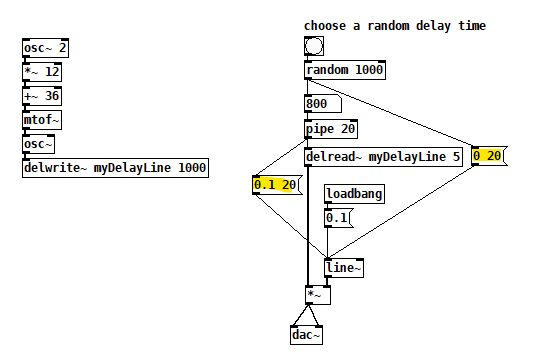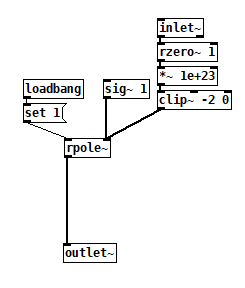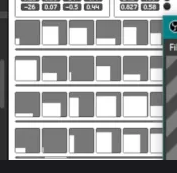-
jameslo
posted in technical issues • read more@whale-av Hey! Don't you need to add the triggers on some of those outputs that have two connections? I'm sure your patch works because your instincts caused you to create those connections in the right order, but still!
-
jameslo
posted in technical issues • read more@ArduinoPrints3D Yes, I think you put the clone start flag in the wrong place so that the clone numbering is really going from 0 to 15. Try [clone -s 1 voicecloner 16]
-
jameslo
posted in technical issues • read more@c_c +1 to @whale-av, and you could also just fade out before changing the delay and then fade back in, e.g.
changing delay.pd
To demonstrate that it's actually doing something, delete the highlighted messages and choose a few more random delay times. Click click pop! -
jameslo
posted in patch~ • read moreA long time ago I needed something that would toggle between 1 and -1 at audio rate whenever its input decreases in value (as would happen when driven by a [phasor~]). This is what I came up with:

The blocksize has to be small enough to accomodate the highest frequency toggling that you need to support.I was convinced that this was the only way possible, and so was completely surprised when I stumbled across this:
 flipflop2~.pd
flipflop2~.pd
Seems so obvious in retrospect!
Edit: OMG, I posted a similar solution 3 years ago and forgot about it. I'm now accepting nursing home recommendations.
-
jameslo
posted in technical issues • read more@whale-av Thanks! While searching for [coords( documentation I stumbled across [goprect( buried in the dynamic patching help. It looks like it's relatively new and doesn't set the dirty flag.
And unless there's a difference in how canvases are messaged, then it seems like the answer to my original question is that the [namecanvas] way let's you send to any accessible named canvas in the patch, whereas pdcontrol is just for the containing canvas and saves you the trouble of having to name it. Other than that they seem equivalent.
-
jameslo
posted in technical issues • read moreI'm sending a [donecanvasdialog....( message to a canvas to resize its GOP. It appears that I can either use [namecanvas] to create a receive on a particular canvas, or I can use the [sendcanvas...( message with [pdcontrol]. Which one should I use?
-
jameslo
posted in technical issues • read more@ben.wes I like your mouse click logic + clipping better because you can drag outside the control to make things maximum or minimum.
For anyone else is trying to understand your patch, I want to correct my faulty explanation. Firstly, there are 2 canvases in the GOP area, one is the grey background that fills it, and one is a smaller white foreground. This latter one receives messages sent to $0-cnv, not the silly thing I wrote before, and its configured size has to be 1 so that vis_size can go to 1.
-
jameslo
posted in technical issues • read more@ben.wes Woah! Look how similar my patch is and how little is missing:

I'm really more amazed by the missing part because it really drives home what I don't know! Wait, that didn't come out right. I mean it's like I'm standing next to the Empire State Building asking people "hey, where's is the Empire State Building?"
I can't find (in 10 minutes of happy hour searching) where either the pos or vis_size messages are documented, so here are my guesses from looking at your code:
- sending to $0-cnv sends messages to the containing canvas
- the visibility window just happens to have the exact same color scheme as Reaktor?!!! Unbelievable coincidence.
- the visibility window is anchored relative to its upper left corner, so that's why you did the pos message that way
- and the size of the window extends down and to the right of the visibility window anchor
How did I do, professor? All kidding aside, thanks so much.
-
jameslo
posted in technical issues • read more
This array of squares is allegedly from Reaktor 6, and they're xy controls. The lower left-justified white rectangle denotes where in the grey square the control point is.How would you recommend I approach making something like this? I'd like the enclosing square to be GOP from an abstraction. I made something that gets the xy coordinates using else/canvas.mouse, but it doesn't display what the current xy value is. Do I have to try to learn data structures (again)?
PS: the actual sq/rectangle colors don't matter to me. I don't see an easy way to paint the GOP window some other color than white.
